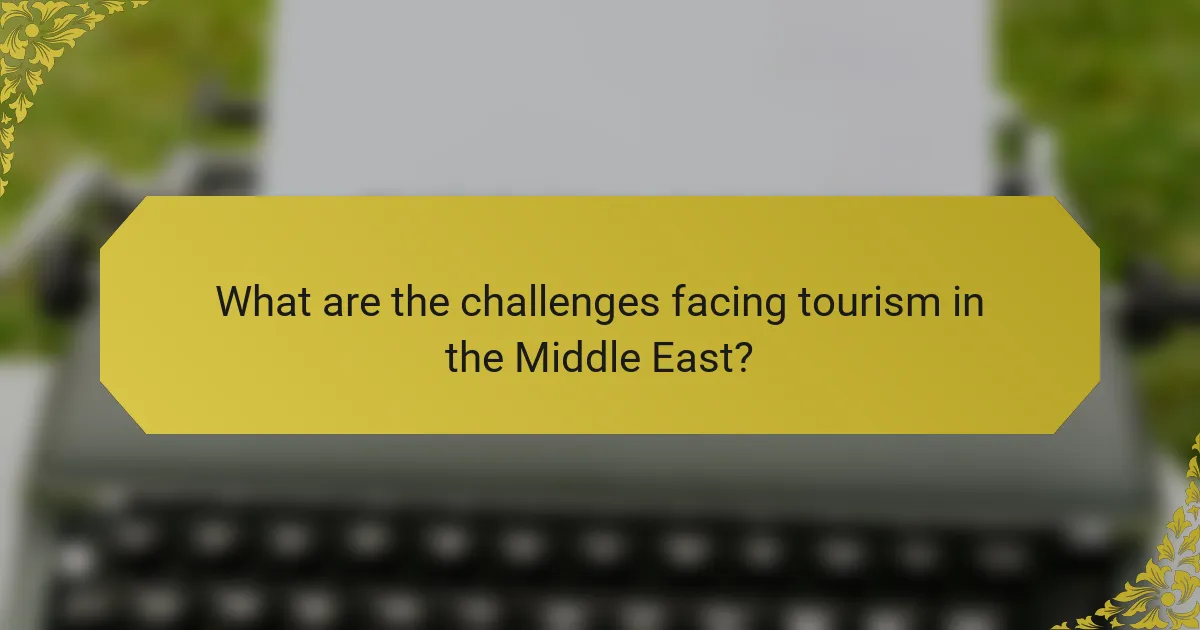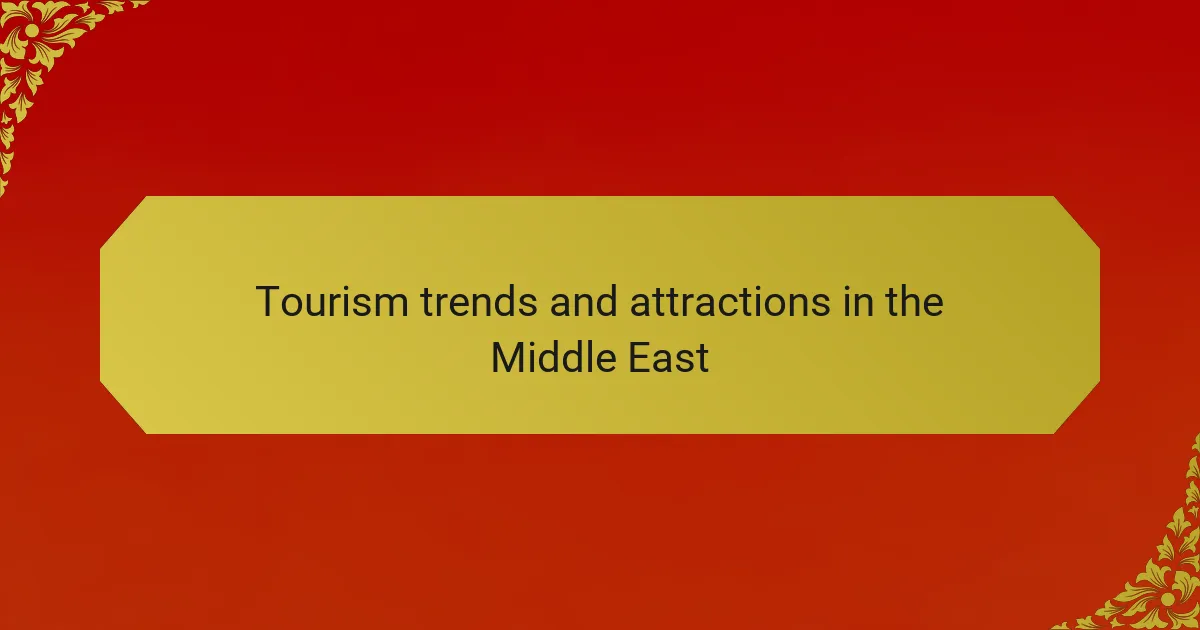
What are the current tourism trends in the Middle East?
Current tourism trends in the Middle East include a rise in luxury travel, cultural tourism, and eco-tourism. Luxury travel is gaining popularity as destinations enhance high-end experiences. Countries like the UAE and Saudi Arabia are investing in luxury hotels and resorts. Cultural tourism is also on the rise, with travelers seeking authentic experiences. Historical sites and local traditions attract visitors to countries such as Jordan and Egypt. Eco-tourism is emerging as travelers prioritize sustainability. Destinations are promoting natural landscapes and wildlife conservation efforts. Additionally, digital nomadism is increasing, as remote work allows longer stays. The region is adapting to these trends with improved infrastructure and services.
How have tourism patterns evolved in recent years?
Tourism patterns in recent years have shifted significantly due to various global influences. The COVID-19 pandemic drastically impacted travel, leading to a temporary decline in international tourism. As restrictions eased, there was a notable resurgence in domestic travel. Travelers increasingly seek unique experiences over traditional sightseeing. Sustainable tourism has gained traction, with more tourists prioritizing eco-friendly options. Digital nomadism has also risen, with people blending work and travel. According to the UN World Tourism Organization, international arrivals increased by 83% in 2022 compared to 2021. This recovery trend highlights the resilience of the tourism sector.
What factors are influencing these changes in tourism trends?
Changing consumer preferences are influencing tourism trends. Travelers increasingly seek authentic experiences and cultural immersion. Sustainability concerns also shape choices, with many preferring eco-friendly options. The rise of digital technology impacts how travelers plan and book trips. Social media influences destination popularity and travel behavior. Health and safety considerations remain paramount post-pandemic. Economic factors, such as disposable income and exchange rates, affect travel decisions. Lastly, geopolitical stability plays a crucial role in attracting tourists to the Middle East.
How do economic conditions impact tourism in the region?
Economic conditions significantly impact tourism in the region. A strong economy increases disposable income, leading to higher travel spending. Conversely, economic downturns can reduce travel budgets and lower tourist numbers. For instance, during the 2008 financial crisis, many regions saw a decline in international tourist arrivals. Additionally, currency fluctuations can affect travel affordability. A stronger local currency may deter foreign visitors due to higher costs. Conversely, a weaker currency can attract tourists seeking value. Employment rates also play a role; higher employment can boost domestic tourism as more individuals can afford to travel. Overall, economic stability fosters a thriving tourism sector, while instability can hinder growth.
What role does technology play in shaping tourism experiences?
Technology significantly enhances tourism experiences by facilitating information access and improving service delivery. It allows travelers to research destinations, book accommodations, and plan itineraries with ease. Mobile applications provide real-time updates on travel conditions and local attractions. Virtual reality enables potential tourists to preview experiences before visiting. Social media platforms influence travel decisions through user-generated content and reviews. Data analytics helps businesses tailor offerings to customer preferences. For instance, 70% of travelers use mobile devices for travel planning, highlighting technology’s impact on decision-making. Overall, technology streamlines processes and enriches the overall travel experience.
How are digital platforms transforming travel planning?
Digital platforms are revolutionizing travel planning by providing instant access to information and services. Travelers can now compare prices, read reviews, and book accommodations in real-time. Mobile apps and websites streamline the planning process. They offer personalized recommendations based on user preferences. Social media platforms enable travelers to share experiences and tips. Data analytics help platforms predict trends and enhance user experiences. According to a 2020 report by Statista, over 70% of travelers use online platforms for booking. This shift has made travel more accessible and efficient for users.
What technologies are enhancing visitor engagement at attractions?
Virtual reality (VR) and augmented reality (AR) technologies are enhancing visitor engagement at attractions. VR creates immersive experiences that transport visitors to different environments. For example, VR can simulate historical events or allow exploration of inaccessible locations. AR overlays digital information onto the real world, enriching visitors’ understanding of exhibits. Interactive kiosks and mobile apps provide personalized information and self-guided tours. These technologies cater to diverse visitor preferences, increasing satisfaction. According to a report by the International Association of Amusement Parks and Attractions, 75% of visitors prefer attractions that offer interactive experiences. This trend indicates a growing demand for technology-driven engagement in the tourism sector.

What attractions are driving tourism in the Middle East?
The attractions driving tourism in the Middle East include historical sites, modern architecture, and cultural experiences. Iconic landmarks like the Pyramids of Giza and Petra draw millions of visitors annually. The Burj Khalifa in Dubai showcases modern engineering and luxury. Cultural festivals, such as the Abu Dhabi Film Festival, attract global audiences. Religious tourism to sites like Mecca and Jerusalem remains significant. Adventure tourism, including desert safaris and scuba diving in the Red Sea, is growing in popularity. Shopping destinations, such as the Dubai Mall, enhance the region’s appeal. These attractions collectively contribute to the Middle East’s status as a diverse tourism hub.
Which cultural and historical sites are most popular among tourists?
The most popular cultural and historical sites among tourists in the Middle East include the Pyramids of Giza, Petra, and the Western Wall. The Pyramids of Giza, located in Egypt, are one of the Seven Wonders of the Ancient World. They attract millions of visitors annually, showcasing ancient Egyptian civilization. Petra, in Jordan, is renowned for its rock-cut architecture and water conduit system. It is a UNESCO World Heritage site and draws tourists for its historical significance and stunning visuals. The Western Wall in Jerusalem is a sacred site for Jews and is visited by millions each year. These sites exemplify the rich cultural and historical heritage of the Middle East, making them top destinations for tourists.
What unique features do these sites offer to visitors?
Unique features of tourism sites in the Middle East include rich cultural heritage, stunning architecture, and diverse landscapes. Visitors experience ancient historical sites like Petra and the Pyramids of Giza. Many sites offer immersive cultural experiences, such as traditional music and dance performances. Culinary tours highlight unique regional cuisine, showcasing flavors from various countries. Adventure tourism opportunities include desert safaris and scuba diving in the Red Sea. Some destinations feature luxury accommodations with world-class amenities. Festivals and events celebrate local traditions, attracting international visitors. These unique features enhance the overall visitor experience and promote cultural exchange.
How do local traditions influence the appeal of these attractions?
Local traditions significantly enhance the appeal of attractions in the Middle East. They create a unique cultural experience for visitors. Traditional festivals, rituals, and customs attract tourists seeking authenticity. For instance, the annual Abu Dhabi Festival showcases local art and music, drawing international attention. Local cuisine, rooted in tradition, offers a culinary journey, enticing food enthusiasts. Additionally, historical practices, such as traditional crafts, provide insight into the region’s heritage. Tourists are often eager to engage with local communities, fostering deeper connections. Such interactions enrich the overall travel experience, making attractions more memorable.
What natural attractions are gaining attention in the region?
Natural attractions gaining attention in the Middle East include the Red Sea, Wadi Rum, and the Al Hajar Mountains. The Red Sea is known for its vibrant coral reefs and diverse marine life. Wadi Rum features stunning sandstone mountains and unique rock formations. The Al Hajar Mountains offer breathtaking landscapes and opportunities for hiking. These sites are increasingly popular due to their natural beauty and adventure tourism potential. Recent reports indicate a rise in eco-tourism activities in these areas. Visitors are drawn to outdoor experiences and cultural heritage. The region’s natural attractions are becoming key components of tourism strategies.
What types of outdoor activities are available for tourists?
Tourists can engage in various outdoor activities in the Middle East. Popular options include hiking in mountainous regions, such as the Al Hajar Mountains in Oman. Desert safaris offer thrilling experiences across the vast dunes of countries like UAE and Saudi Arabia. Water sports, including snorkeling and diving, are available along the Red Sea coast in Egypt and Jordan. Cultural experiences, such as camel riding and visiting traditional markets, also attract tourists. Adventure activities like rock climbing and paragliding are gaining popularity in Lebanon and Turkey. Eco-tourism initiatives promote wildlife watching in nature reserves. Each of these activities caters to diverse interests and enhances the tourist experience in the region.
How do these natural sites contribute to eco-tourism?
Natural sites contribute to eco-tourism by providing unique environments for sustainable travel experiences. They attract visitors seeking to engage with nature while minimizing their ecological footprint. These sites often support conservation efforts, protecting biodiversity and ecosystems. For instance, the establishment of protected areas encourages responsible tourism practices. In the Middle East, natural sites like deserts and mountains offer opportunities for activities such as hiking and wildlife observation. These activities promote environmental awareness among tourists. Additionally, local communities benefit economically from eco-tourism, fostering a sustainable relationship between tourism and conservation.

What are the challenges facing tourism in the Middle East?
The challenges facing tourism in the Middle East include political instability, security concerns, and inadequate infrastructure. Political instability in countries like Syria and Iraq deters potential visitors. Security concerns, particularly related to terrorism, have a significant impact on tourist confidence. Inadequate infrastructure, such as transportation and accommodation, limits accessibility to key attractions. Additionally, cultural misunderstandings can create barriers for tourists. Seasonal climate extremes can also affect travel plans. These factors collectively hinder the growth of the tourism sector in the region.
How do geopolitical factors affect tourist perceptions?
Geopolitical factors significantly influence tourist perceptions. These factors include political stability, security concerns, and international relations. For instance, regions experiencing conflict or unrest often see a decline in tourist interest. Travelers prioritize safety when choosing destinations. A report by the World Economic Forum indicates that perceived safety directly impacts tourism revenue. Additionally, diplomatic relations can enhance or hinder travel perceptions. Countries with positive international standing attract more visitors. Conversely, negative media coverage can deter potential tourists. Overall, geopolitical factors shape the narrative surrounding a destination, affecting tourist decisions.
What measures are being taken to ensure visitor safety?
Visitor safety measures include enhanced security protocols at attractions. Many sites have implemented advanced surveillance systems. These systems help monitor crowds and detect potential threats. Trained security personnel are present to respond to incidents promptly. Emergency response plans are in place for various situations. Health and safety guidelines are enforced to prevent accidents. Regular safety drills ensure staff readiness. These measures collectively enhance the overall safety for visitors in the Middle East.
How does political stability influence travel decisions?
Political stability significantly influences travel decisions by affecting travelers’ perceptions of safety and security. Tourists tend to avoid regions with political unrest or instability. For instance, according to a 2018 report by the World Economic Forum, destinations with high levels of political stability receive 20% more international visitors compared to those with instability. Travelers prioritize their well-being, leading them to choose destinations perceived as safe. Additionally, political stability often correlates with reliable infrastructure and services, enhancing the travel experience. In contrast, areas experiencing conflict or protests may see a decline in tourism revenue, as seen in countries like Egypt during periods of unrest.
What environmental concerns impact tourism development?
Environmental concerns impacting tourism development include climate change, habitat destruction, and pollution. Climate change affects weather patterns, leading to extreme weather events that can deter tourists. Habitat destruction, often due to infrastructure development, threatens local ecosystems and biodiversity. Pollution, including air and water contamination, diminishes the attractiveness of tourist destinations. For instance, the World Tourism Organization reported that sustainable tourism practices can mitigate these issues. Additionally, rising sea levels threaten coastal tourism areas, particularly in regions like the Middle East. Addressing these concerns is crucial for sustainable tourism development.
How are destinations addressing sustainability in tourism?
Destinations are addressing sustainability in tourism through various initiatives. Many are implementing eco-friendly practices to reduce environmental impact. For example, some regions are promoting renewable energy sources for hotels and attractions. Others encourage sustainable transportation options, like electric vehicles and bike rentals. Additionally, destinations are focusing on conservation efforts to protect local wildlife and habitats. They also engage in community-based tourism to support local economies. Many are offering educational programs to raise awareness about sustainability among tourists. According to the United Nations World Tourism Organization, sustainable tourism can enhance the visitor experience while preserving cultural and natural resources.
What role does conservation play in protecting attractions?
Conservation plays a critical role in protecting attractions by preserving their natural and cultural integrity. It ensures that ecosystems remain healthy and that historical sites retain their significance. Effective conservation practices prevent degradation caused by tourism and environmental factors. For instance, protected areas in the Middle East, like Wadi Rum in Jordan, showcase how conservation helps maintain biodiversity and cultural heritage. Research indicates that sustainable tourism practices, supported by conservation efforts, can enhance visitor experiences while safeguarding attractions for future generations.
What are the best practices for travelers visiting the Middle East?
Travelers visiting the Middle East should respect local customs and traditions. Understanding cultural norms is essential. Dress modestly, especially in religious sites. Many countries in the region have specific dress codes. For example, women should cover their shoulders and knees.
Travelers should learn basic Arabic phrases. Simple greetings can enhance interactions with locals. Additionally, it’s important to be aware of local laws. Some behaviors acceptable elsewhere may be illegal in the Middle East. For instance, public displays of affection are often frowned upon.
Travelers are advised to stay hydrated and be cautious of the heat. The climate can be extremely hot, especially in summer. Moreover, it’s wise to plan visits during cooler months. This can enhance the overall experience.
Using reputable transportation options is recommended. Ride-sharing apps and licensed taxis are generally safe. Lastly, travelers should stay informed about current events. Monitoring travel advisories ensures safety during their visit.
How can tourists respect local customs and traditions?
Tourists can respect local customs and traditions by researching cultural norms before visiting. Understanding dress codes is essential; many Middle Eastern countries require modest clothing. Tourists should also learn basic greetings in the local language. This shows respect and appreciation for the culture. Observing local customs during religious practices is crucial. For instance, tourists should refrain from eating in public during Ramadan. Additionally, participating in local festivals can enhance cultural understanding. Engaging with local communities respectfully fosters positive interactions. Following these practices helps maintain cultural integrity and promotes mutual respect.
What tips can enhance the travel experience in the region?
Research local customs before visiting. Understanding cultural norms enhances interactions. Dress modestly to respect traditions. Engage with locals to gain insights. Use local transportation for an authentic experience. Try regional cuisine to explore flavors. Plan visits during festivals for unique experiences. Stay hydrated due to the climate.
The main entity of this article is tourism trends and attractions in the Middle East. The article examines current trends such as luxury travel, cultural tourism, and eco-tourism, highlighting the evolving patterns influenced by consumer preferences and technological advancements. It details popular attractions, including historical sites and natural landscapes, while addressing challenges like political instability and environmental concerns. Additionally, the article discusses best practices for travelers to enhance their experience and respect local customs.


